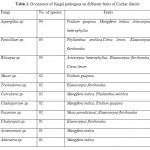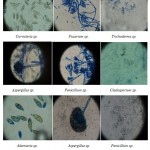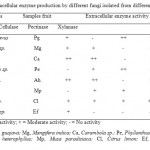Isolation and Identification of Fungi Associated with Local Fruits of Barak Valley, Assam
Benkee Thiyam1 * and G.D. Sharma2
1
Microbiology Laboratory,
Department of Life Science and Bioinformatics,
Assam University,
Silchar,
788 011
India
2
Bilaspur University,
Village Sendri,
Chattisgarh,
495 009
India
DOI: http://dx.doi.org/10.12944/CWE.8.2.20
Copy the following to cite this article:
Thiyam B, Sharma G. D. Isolation and Iidentification of Fungi Associated with Local Fruits of Barak Valley, Assam. Curr World Environ 2013;8(2) DOI:http://dx.doi.org/10.12944/CWE.8.2.20
Copy the following to cite this URL:
Thiyam B, Sharma G. D. Isolation and Iidentification of Fungi Associated with Local Fruits of Barak Valley, Assam. Curr World Environ 2013;8(2). Curr World Environ 2013;8(2). Available from: http://www.cwejournal.org/?p=4859
Download article (pdf)
Citation Manager
Publish History
Select type of program for download
| Endnote EndNote format (Mac & Win) | |
| Reference Manager Ris format (Win only) | |
| Procite Ris format (Win only) | |
| Medlars Format | |
| RefWorks Format RefWorks format (Mac & Win) | |
| BibTex Format BibTex format (Mac & Win) |
Article Publishing History
| Received: | 2013-06-28 |
|---|---|
| Accepted: | 2013-07-17 |
Fruits make important diet for human beings. The high concentration of various sugars, minerals, vitamins and amino acids also provide a good platform for the successful growth and survival of various parasitic and saprophytic forms of fungi (Fatima et al., 2010). Fruits are highly perishable and maintain an active metabolism during the storage phase. During post harvest period diseases can affect the quality of fruits. Post harvest deterioration of fruits may take place in any stages viz. storage, transit or trans-shipment, during handling processes required to move the crop from the grower to the whole sale dealer and to retailer and finally to consumers. Different types of fruits are grown in Barak valley but low production of these local fruits could not afford the demand of the consumer as they are highly prone to fungal pathogens due to high moisture content and tropical humid climate. In Assam, actual availability of fruits and vegetables in the market goes down by 35% to 40% due to post harvest losses (State Agricultural Policy, Assam 2004).There is no published data on pathogenic fungi which cause the post harvest diseases associated with local fruits. Present investigation was carried out to study of various fungal pathogens responsible for the post harvest, decay and deterioration of economically important fruits from the Cachar district of Assam.
Materials and Methods
The area has an average altitude of 20-40 m asl; falls between 24Ëš15Í N and 25Ëš8Í N latitude and 92Ëš15ÍE and 93Ëš15ÍE longitude and the climate is a tropical humid type. The average rainfall of the valley is 670.9 mm and the mean monthly temperature ranged between 8.5Ëš-36.2Ëš. During the survey infected fruits viz. Citrus limon, Mangifera indica, Musa paradisiaca, Psidium guajava, Elaeocarpus floribundus, Phyllanthus emblica, Artocarpus heterophyllus, and Carambola sp. were collected from different markets of Cachar district. Eight wild fruits were selected for the study of fruits from wooden packeted storage condition. Storage condition was in a dark room. Mature fruits as well as infected fruits were collected from these sites in a sterile polyethylene bags. Samples were brought to the laboratory in separate sterilized polythene bags. (Alexopoulos,1961 and Malik,1996). The sampled fruits were surface sterilized for 3 min with 1% NaOCl and rinsed in four successive changes of sterile distilled water. The surface sterilized fruits showing symptoms of diseases were then sliced into 2mm² pieces and plated on to steriled potato dextrose agar (PDA) in Petri dishes in three replicates. The plates were incubated in an inverted position at 26-30á´¼C for five days. The isolated fungi were identified on the basis of macromorphological and micromorphological characteristics. The following morphological characteristics viz. colony growth, presence or absence of aerial mycelium, colony color, presence of wrinkles and furrows, pigment production etc. were recorded. In some cases the infected tissues were stained by cotton blue and Lactophenol (Mc Lean and Ivimey,1965) and observed under compound microscope. The morphological identification of fungal pathogen was based on the morphology of the fungal culture colony or hyphae, the characteristics of the spores and reproductive structures (Barnett and Hunter,1998).
Results and Discussion
 |
Table 1: Occurrence of fungal pathogens on different fruits of Cachar district Click here to View table |
Table 1. shows that twenty three fungal isolates were associated with the fruits of Cachar districts. During the survey of the storage of fruits in the market, number fungal pathogens which causes the spoilage of fruits were observed. Acremonium, Alternaria, Aspergillus, Chalaropsis, Cladosporium, Curvularia, Fusarium, Mucor, Penicillium, Rhizopus, and Trichoderma were isolated from fruit samples. Among the fungal isolates Aspergillus was found to be the most dominant ones responsible for extensive damage of fruits in the markets of Cachar district of Southern Assam. Similar results on post harvest fungal pathogens on market storage of fruits were reported by earlier workers (Bhale ,2011 and Gadgile, 2011).Similarly, Rathod (2010) reported post harvest fungal diseases of some fruits of Marathwada regions of Maharashtra.
 |
Figure 1: Displaying some fungal isolates from fruits Click here to View figure |
 |
Table 2: Extracellular enzyme production by different fungi isolated from different fruits Click here to View table |
Fungal isolates showed a diverse enzyme activity in terms of extracellular enzyme production in agar plates assay (Table 2). Fungal isolates, Alternaria sp. and Curvularia sp. showed high produced more amylase activity whereas it was observed in Aspergillus flavus and Cladosporium sp. for pectolytic avtivity. High xylanase activity was observed in Penicillium sp.. Amylolytic activity was not detected for Cladosporium sp. and Fusarium sp. whereas, Aspergillus flavus, Penicillium sp. and Trichoderma sp. lacked cellulolytic activity. Similarly, pectinolytic activity was not observed for Acremonium sp., Alternaria sp., Fusarium sp,. Trichoderma sp. and xylanase production was not observed in Acremonium sp., Cladosporium sp., Penicillium sp. and Trichoderma sp. Agar plates enzyme assay had demonstrated that fungal isolates can able to utilize organic compounds which are major components of fruit tissues. This study has provided useful information about the toxigenic fungi associated with local fruits which may affects the human health. Spoiled fruits should be sorted and eliminated to avoid toxins usually associated with the growth of fungi.
References
- Alexopoulos, C.J. (1961). Introductory Mycology, pp: 229–30. John Wiley and Sons, Inc., New York.
- Al-Hindi, R. R., Al-Najada,R.A., and Mohamed,S,A.(2011). Isolation and identification of some fruit spoilage fungi: Screening of plant cell wall degrading enzymes. African Journal of Microbiology, Vol. 5(4): pp. 443-448.
- Barnett, HL, and Hunter, B.B. (1972) Illustrated genera of Imperfect Fungi.Burgess Publishing Company, Third edition.
- Bhale,U.N. (2011).Survey of market storage diseases of some important fruits of Osmannabad District (M. S.) India Science Research Reporter 1(2):88-91.
- Das,K.(2011).Occurrence of endophytic fungi on sal tree (Shorea robusta G.f.) in forest of Chattisgarh.J. Mycopathologiccal, Res, 49(1):39-45.
- Gadgile,D.P., Kakde,R.B., Rathod,G.M. and Chavan,A.M.(2010).Post-harvest fungal diseases of some tropical fruits.Biosci.Disc,.1(1):7-10.
- Garcha,H.S. and Singh,V.(1980).Post harvest diseases of fruits in Punjab. Indian Phytopathol.33(1):42-47.
- Majumdar,V.L. and Pathak, V.N.(1989).Incidence of major post harvest diseases of guava fruits in Jaipur markets. Indian Phytopatho.42:469.
- Malik, B.S. (1996). A Laboratory Manual of Veterinary Microbiology, Part III. Pathogenic Bacteriology and Mycology, 4th Ed., pp: 137–46.
- McClenny, N. (2005) Laboratory detection and identification of Aspergillus species by microscopic observation and culture: the traditional approach. Medical Mycology Supplement,43: S125-S128.
- Nelson,S.(2005). Rhizopus Rot of Jackfruit. Plant Disease , PD-29.
- Rathod, G.M. (2010) Survey of Post harvest Fungal diseases of Some fruits from Marathwada regions of Maharashtra, India. Jour. of Ecobiotechnology.2/6:07-10.






